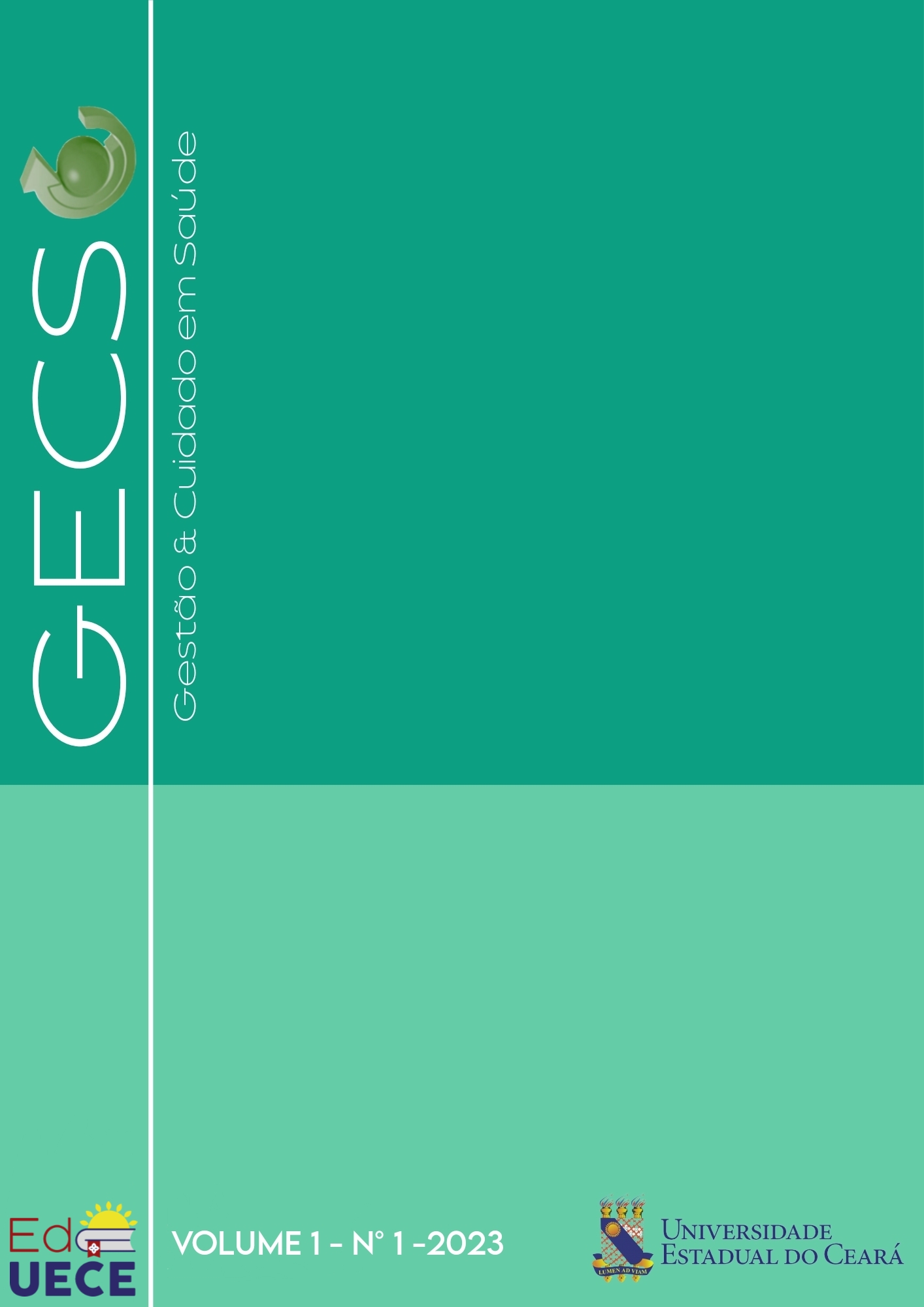Prevalência e fatores associados a dor lombar em adolescentes escolares: Um estudo transversal
DOI:
https://doi.org/10.70368/gecs.v1i1.12241Palavras-chave:
Adolescente, Dor lombar, Fatores de riscoResumo
O objetivo deste estudo foi avaliar a prevalência e fatores associados a dor lombar em adolescentes escolares. Trata-se de um estudo transversal, desenvolvido entre setembro e outubro de 2019, nas Escolas Estaduais de Educação Profissional (EEEPs). A população-alvo foi composta por 286 adolescentes, de 15 a 19 anos. Foram incluídos escolares regularmente matriculados nas escolas selecionadas, compondo uma amostra probabilística. Aplicou-se os questionários: Sociodemográfico e histórico de saúde; International Physical Activity Questionnaire (IPAQ); Smartphone Addiction Inventory (SPAI-BR); Questionário Nórdico de Sintomas Musculoesqueléticos (NMQ) e Self-Report Questionnaire (SRQ-20). Os dados dos analisados pela estatística descritiva e inferencial pelo programa SPSS Statistic versão 23.0 IBM®, na análise bivariada utilizou-se o teste de Qui-quadrado de Pearson. A média de idade foi de 16,24 (± 1,01), de cor da pele autorreferida parda (53,8%), seguida da cor branca 72 (25,2%), de classes sociais com predomínio D 150 (52,4%) e E 90 (31,5%). A prevalência de dor lambar encontrada foi de 50,7% (n=157). Verificou-se associação significativa entre os adolescentes que são dependentes do smartphone (p=0,024), não dormem bem (p=0,000) e os que apresentaram suspeita de TMC (p=0,000). Foi evidenciada alta prevalência de dor lombar entre os adolescentes, e sua associação com múltiplos fatores. Diante disso, alerta-se para compreensão dessas relações pode ser crucial para desenvolver estratégias de prevenção e intervenção direcionadas para os adolescentes.
Referências
AKBARI-CHEHREHBARGH, Z.; TAVAFIAN, S. S.; MONTAZERI, A. Erratum: Correction to: Effectiveness of a theory-based back care intervention on spine-related behavior among pupils: a school-based randomised controlled trial (T-Bak study) (BMC public health (2020) 20 1 (805)). BMC public health, v. 20, n. 1, p. 1225, 2020. Disponível em: https://bmcpublichealth.biomedcentral.com/articles/10.1186/s12889-020-08566-z. DOI: https://doi.org/10.1186/s12889-020-09200-8
ASSIRI, A. et al. Back pain and schoolbags among adolescents in Abha city, Southwestern Saudi Arabia. International Journal of Environmental Research and Public Health, v. 17, n. 1, p. 1–9, 2020. Disponível em: https://www.ncbi.nlm.nih.gov/pmc/articles/PMC6981712/. DOI: https://doi.org/10.3390/ijerph17010005
BEN AYED, H. et al. Prevalence, Risk Factors and Outcomes of Neck, Shoulders and Low-Back Pain in Secondary-School Children. Journal of research in health sciences, v. 19, n. 1, p. e00440, 26 Mar. 2019. Disponível em: https://www.ncbi.nlm.nih.gov/pmc/articles/PMC6941626/.
BENTO, T. P. F. et al. Low back pain in adolescents and association with sociodemographic factors, electronic devices, physical activity and mental health. Jornal de Pediatria, v. 96, n. 6, p. 717–724, Nov. 2020. Disponível em: https://www.sciencedirect.com/science/article/pii/S0021755719302797?via%3Dihub. DOI: https://doi.org/10.1016/j.jpedp.2019.07.006
BRASIL, M. DA S. IMC: você sabe calcular seu peso ideal? - Saúde Brasil. Disponível em: https://saudebrasil.saude.gov.br/ter-peso-saudavel/imc-indice-de-massa-corporal-como-calcular-seu-peso-ideal.
CALVO-MUÑOZ, I. et al. Risk Factors for Low Back Pain in Childhood and Adolescence. The Clinical Journal of Pain, v. 34, n. 5, p. 468–484, Mai. 2018. Disponível em: https://pubmed.ncbi.nlm.nih.gov/28915154/. DOI: https://doi.org/10.1097/AJP.0000000000000558
CASSER, H.-R.; SCHAIBLE, H.-G. Muskuloskeletaler Schmerz. Der Schmerz, v. 29, n. 5, p. 486–495, 9 Out. 2015. Disponível em: https://link.springer.com/article/10.1007/s00482-015-0046-9. DOI: https://doi.org/10.1007/s00482-015-0046-9
CHIAROTTO, A.; KOES, B. W. Nonspecific Low Back Pain. New England Journal of Medicine, v. 386, n. 18, p. 1732–1740, 5 Mai. 2022. Disponível em: https://pubmed.ncbi.nlm.nih.gov/35507483/. DOI: https://doi.org/10.1056/NEJMcp2032396
DE BARROS, E. N. C.; ALEXANDRE, N. M. C. Cross-cultural adaptation of the Nordic musculoskeletal questionnaire. International Nursing Review, v. 50, n. 2, p. 101–108, 2003. Disponível em: https://pubmed.ncbi.nlm.nih.gov/12752909/. DOI: https://doi.org/10.1046/j.1466-7657.2003.00188.x
DE JESUS MARI, J.; WILLIAMS, P. A validity study of a psychiatric screening questionnaire (SRQ-20) in primary care in the city of Sao Paulo. British Journal of Psychiatry, v. 148, n. JAN., p. 23–26, 1986. Disponível em: https://pubmed.ncbi.nlm.nih.gov/3955316/. DOI: https://doi.org/10.1192/bjp.148.1.23
DEREVENSKY, J. L.; HAYMAN, V.; LYNETTE GILBEAU. Behavioral Addictions: Excessive Gambling, Gaming, Internet, and Smartphone Use Among Children and Adolescents. Pediatric Clinics of North America, v. 66, n. 6, p. 1163–1182, 2019a. Disponível em: https://pubmed.ncbi.nlm.nih.gov/31679605/. DOI: https://doi.org/10.1016/j.pcl.2019.08.008
DIANAT, I.; ALIPOUR, A.; ASGHARI JAFARABADI, M. Prevalence and risk factors of low back pain among school age children in Iran. Health Promotion Perspectives, v. 7, n. 4, p. 223–229, 26 Set. 2017. Disponível em: https://www.ncbi.nlm.nih.gov/pmc/articles/PMC5647358/. DOI: https://doi.org/10.15171/hpp.2017.39
FARES, J.; FARES, M. Y.; FARES, Y. Musculoskeletal neck pain in children and adolescents: Risk factors. Surgical Neurology International, v. 8, n. 72, p. 1–5, 2017. Disponível em: https://www.ncbi.nlm.nih.gov/pmc/articles/PMC5445652/. DOI: https://doi.org/10.4103/sni.sni_445_16
FRANÇA, E. F. et al. Back pain in elementary schoolchildren is related to screen habits. AIMS Public Health, v. 7, n. 3, p. 562–573, 2020. Disponível em: https://www.ncbi.nlm.nih.gov/pmc/articles/PMC7505789/. DOI: https://doi.org/10.3934/publichealth.2020045
FRANCO, D. C. et al. Validade das medidas do tempo sentado do questionário IPAQ-versão curta em universitários brasileiros. Revista Brasileira de Atividade Física & Saúde, v. 26, p. 1–9, 2021. Disponível em: https://rbafs.org.br/RBAFS/article/view/14538. DOI: https://doi.org/10.12820/rbafs.26e0223
HARRISON, L.; WILSON, S.; MUNAFÒ, M. R. Exploring the Associations between Sleep Problems and Chronic Musculoskeletal Pain in Adolescents: A Prospective Cohort Study. Pain Research and Management, v. 19, n. 5, p. e139–e145, 2014. Disponível em: https://www.ncbi.nlm.nih.gov/pmc/articles/PMC4197758/. DOI: https://doi.org/10.1155/2014/615203
HWANG, J. et al. Low back pain in children: a rising concern. European Spine Journal, v. 28, n. 2, p. 211–213, Fev. 2019. Disponível em: https://pubmed.ncbi.nlm.nih.gov/30506290/. DOI: https://doi.org/10.1007/s00586-018-5844-1
INSTITUTO BRASILEIRO DE GEOGRAFIA E ESTATÍSTICA. IBGE. PNS - Pesquisa Nacional de Saúde. Disponível em: https://www.ibge.gov.br/estatisticas/sociais/saude/9160-pesquisa-nacional-de-saude.html.
KĘDRA, A. et al. Physical activity and low back pain in children and adolescents: a systematic review. European Spine Journal, v. 30, n. 4, p. 946–956, 26 Abr. 2021. Disponível em: https://pubmed.ncbi.nlm.nih.gov/32845380/. DOI: https://doi.org/10.1007/s00586-020-06575-5
KHOURY, J. M. et al. Assessment of the accuracy of a new tool for the screening of smartphone addiction. PLoS ONE, v. 12, n. 5, p. 1–13, 2017. Disponível em: https://journals.plos.org/plosone/article?id=10.1371/journal.pone.0176924. DOI: https://doi.org/10.1371/journal.pone.0176924
KUORINKA, I. et al. Standardised Nordic questionnaires for the analysis of musculoskeletal symptoms. Applied Ergonomics, v. 18, n. 3, p. 233–237, 1987. Disponível em: https://pubmed.ncbi.nlm.nih.gov/15676628/. DOI: https://doi.org/10.1016/0003-6870(87)90010-X
LEMOS, A. T. DE et al. Ocorrência de dor lombar e fatores associados em crianças e adolescentes de uma escola privada do sul do Brasil. Cadernos de Saúde Pública, v. 29, n. 11, p. 2177–2185, Nov. 2013. Disponível em: https://www.scielo.br/j/csp/a/KnRJH9C4KR7hf4DYCjQj4Wj/abstract/?lang=pt. DOI: https://doi.org/10.1590/0102-311x00030113
LÓPEZ HERNÁNDEZ, T. et al. Relationship between School Backpacks and Musculoskeletal Pain in Children 8 to 10 Years of Age: An Observational, Cross-Sectional and Analytical Study. International Journal of Environmental Research and Public Health, v. 17, n. 7, p. 2487, 2020. Disponível em: https://www.ncbi.nlm.nih.gov/pmc/articles/PMC7177975/. DOI: https://doi.org/10.3390/ijerph17072487
MATSUDO, S. et al. Questionário Internacional De Atividade Física (Ipaq): Estupo De Validade E Reprodutibilidade No Brasil. Revista Brasileira de Atividade Física & Saúde, v. 6, n. 2, p. 5–18, 2001. Disponível em: https://rbafs.org.br/RBAFS/article/view/931.
MINGHELLI, B. Low back pain in childhood and adolescence phase: consequences, prevalence and risk factors - a revision. Journal of Spine, v. 06, n. 01, 2017. Disponível em: https://pdfs.semanticscholar.org/fb9b/535a6b97d51660de25f8e6f15fe097399604.pdf. DOI: https://doi.org/10.4172/2165-7939.1000351
MONCER, R. et al. Cross-sectional study of low-back pain (LBP) in children and adolescents: Prevalence and risk factor. Annals of Physical and Rehabilitation Medicine, v. 59, p. e96, Set. 2016. Disponível em: https://www.sciencedirect.com/science/article/pii/S1877065716302974?via%3Dihub. DOI: https://doi.org/10.1016/j.rehab.2016.07.217
ONOFRIO, A. C. et al. Acute low back pain in high school adolescents in Southern Brazil: prevalence and associated factors. European Spine Journal, v. 21, n. 7, p. 1234–1240, 3 Jul. 2012. Disponível em: https://pubmed.ncbi.nlm.nih.gov/22048405/. DOI: https://doi.org/10.1007/s00586-011-2056-3
PINHEIRO, F. A.; TRÓCCOLI, B. T.; CARVALHO, C. V. DE. Validação do Questionário Nórdico de Sintomas Osteomusculares como medida de morbidade. Revista de Saúde Pública, v. 36, n. 3, p. 307–312, 2002. Disponível em: https://www.scielo.br/j/rsp/a/CnkzdkBPgkDg4j4Mz6c9nPw/abstract/?lang=pt. DOI: https://doi.org/10.1590/S0034-89102002000300008
ROMAN-JUAN, J.; JENSEN, M. P.; MIRÓ, J. Increases in Sleep Difficulties and Psychological Symptoms are Associated with the Increase of Chronic Back Pain in Adolescents: The HBSC Study 2002 to 2018. The Journal of Pain, Set. 2023. Disponível em: https://www.sciencedirect.com/science/article/abs/pii/S152659002300531X?via%3Dihub. DOI: https://doi.org/10.1016/j.jpain.2023.09.004
SAINZ DE BARANDA, P. et al. Sagittal standing spinal alignment and back pain in 8 to 12-year-old children from the Region of Murcia, Spain: The ISQUIOS Program. Journal of Back and Musculoskeletal Rehabilitation, v. 33, n. 6, p. 1003–1014, 2020. Disponível em: https://pubmed.ncbi.nlm.nih.gov/32924979/. DOI: https://doi.org/10.3233/BMR-191727
SHAN, Z. et al. Correlational Analysis of neck/shoulder Pain and Low Back Pain with the Use of Digital Products, Physical Activity and Psychological Status among Adolescents in Shanghai. PLoS ONE, v. 8, n. 10, p. e78109, 11 Out. 2013. Disponível em: https://journals.plos.org/plosone/article?id=10.1371/journal.pone.0078109. DOI: https://doi.org/10.1371/journal.pone.0078109
SILVA, G. R. R. et al. Prevalence of musculoskeletal pain in adolescents and association with computer and videogame use. Jornal de Pediatria, v. 92, n. 2, p. 188–196, Mar. 2016. Disponível em: DOI: https://doi.org/10.1016/j.jpedp.2015.12.007
https://www.scielo.br/j/jped/a/K4msSJ3DtbCrzv3ZxRDcGHK/?lang=en.
TREVELYAN, F. C.; LEGG, S. J. Risk factors associated with back pain in New Zealand school children. Ergonomics, v. 54, n. 3, p. 257–262, 9 Mar. 2011. Disponível em: https://www.tandfonline.com/doi/full/10.1080/00140139.2010.547608. DOI: https://doi.org/10.1080/00140139.2010.547608
YANG, S.-Y. et al. Association Between Smartphone Use and Musculoskeletal Discomfort in Adolescent Students. Journal of Community Health, v. 42, n. 3, p. 423–430, 12 Jun. 2017. Disponível em: https://pubmed.ncbi.nlm.nih.gov/27734246/. DOI: https://doi.org/10.1007/s10900-016-0271-x
Downloads
Publicado
Como Citar
Licença
Copyright (c) 2024 Francisco Valter Miranda Silva, Paula Pessoa de Brito Nunes, Guilherme da Silva Gomes, Francisco Felipe Cardoso Rabelo, Alanda Luiza Da Silva Pinheiro, Francisco Suivan Rodrigues Quinto Duarte, Valdeni de Sousa Nascimento , Elenita Justino Custodio, Ana Paula Vasconcellos Abdon

Este trabalho está licenciado sob uma licença Creative Commons Attribution 4.0 International License.
















